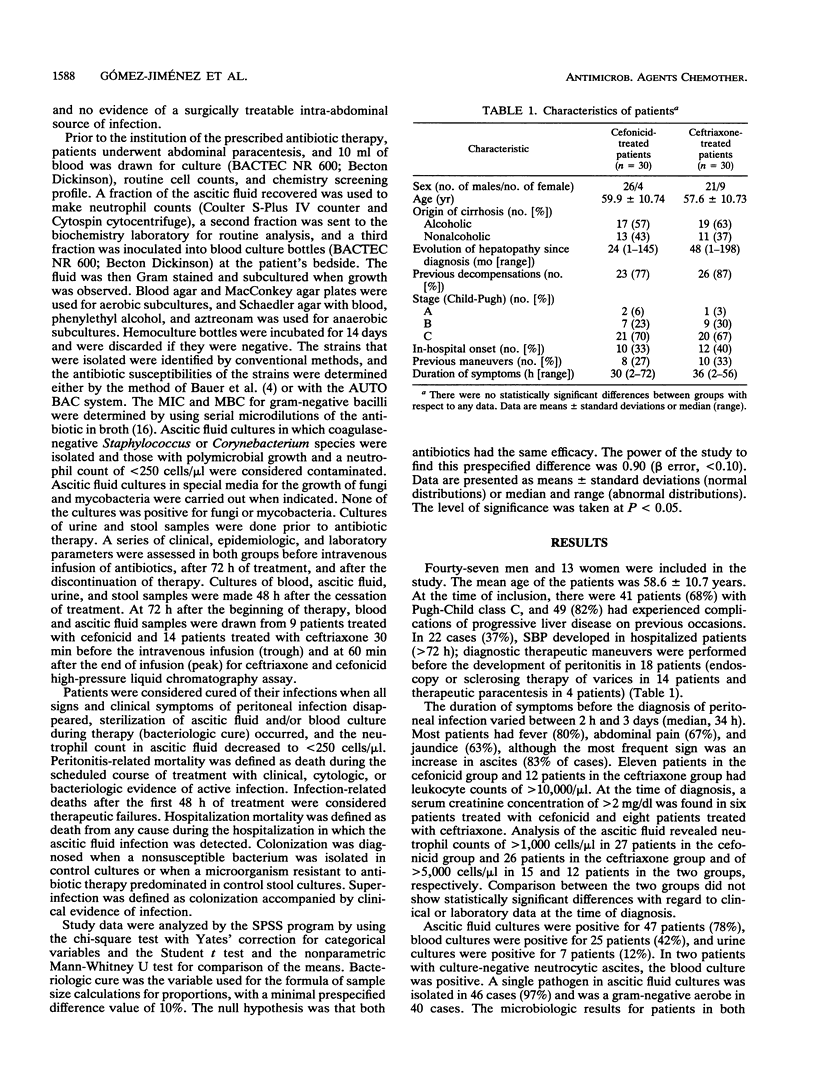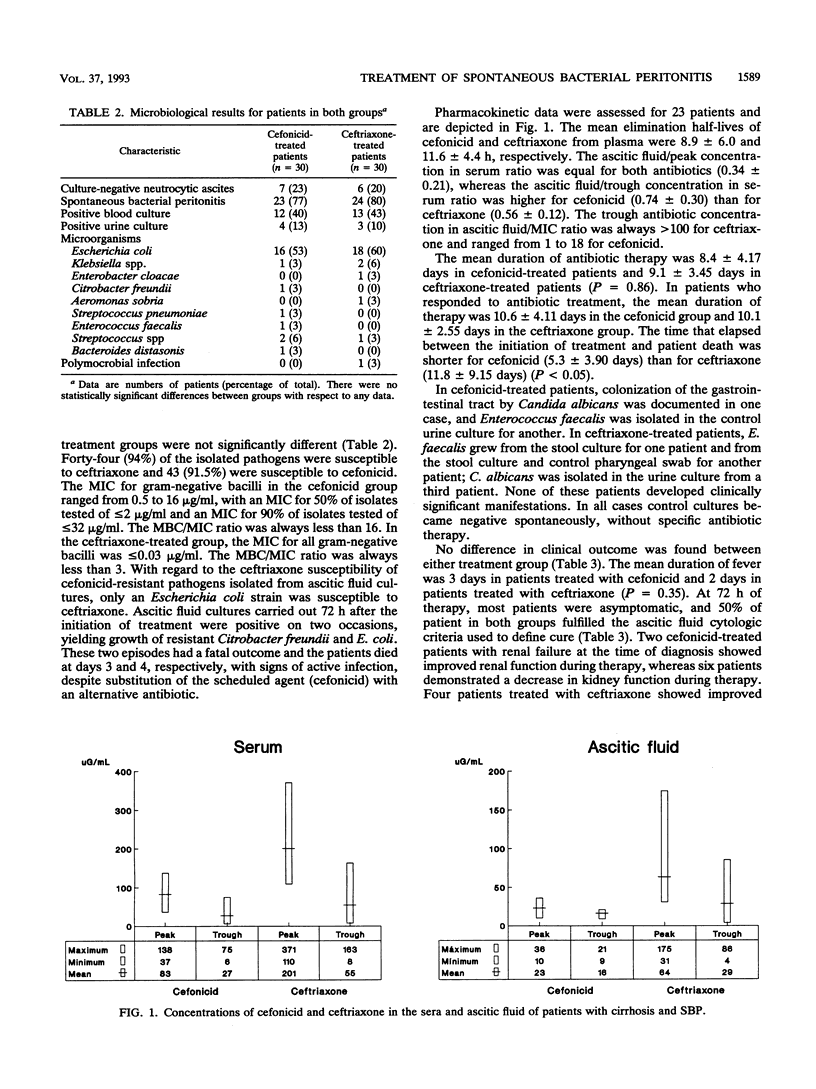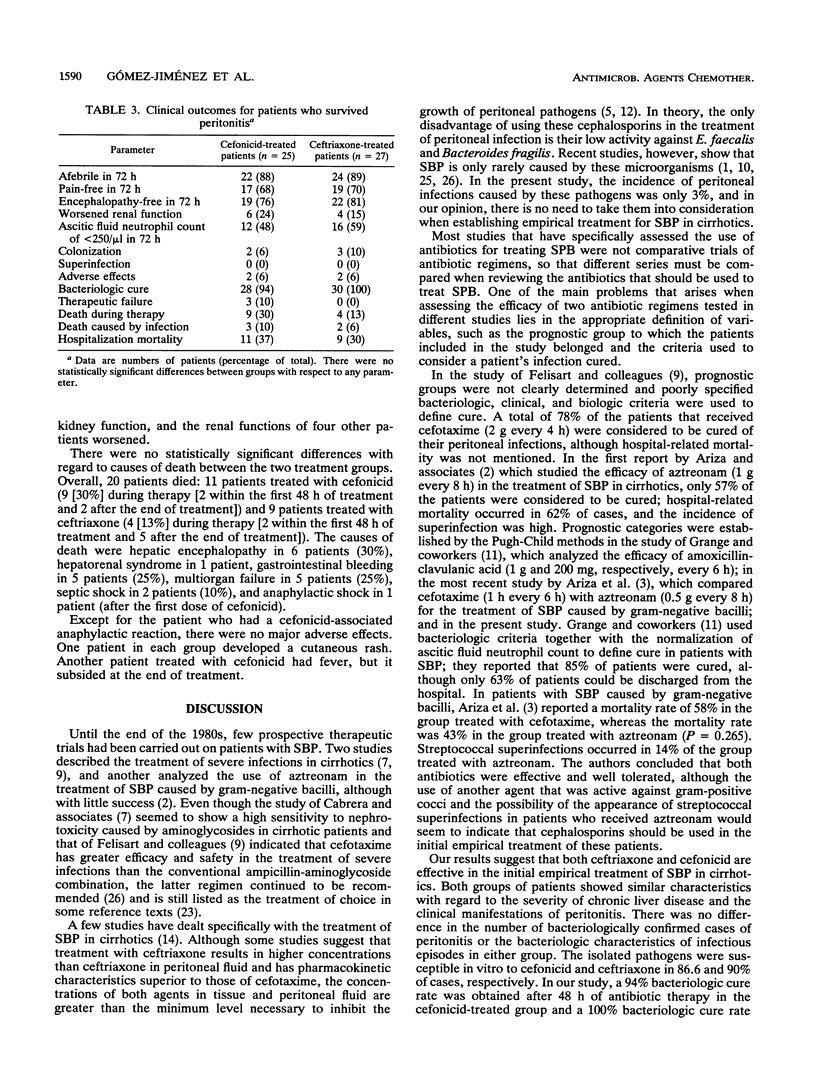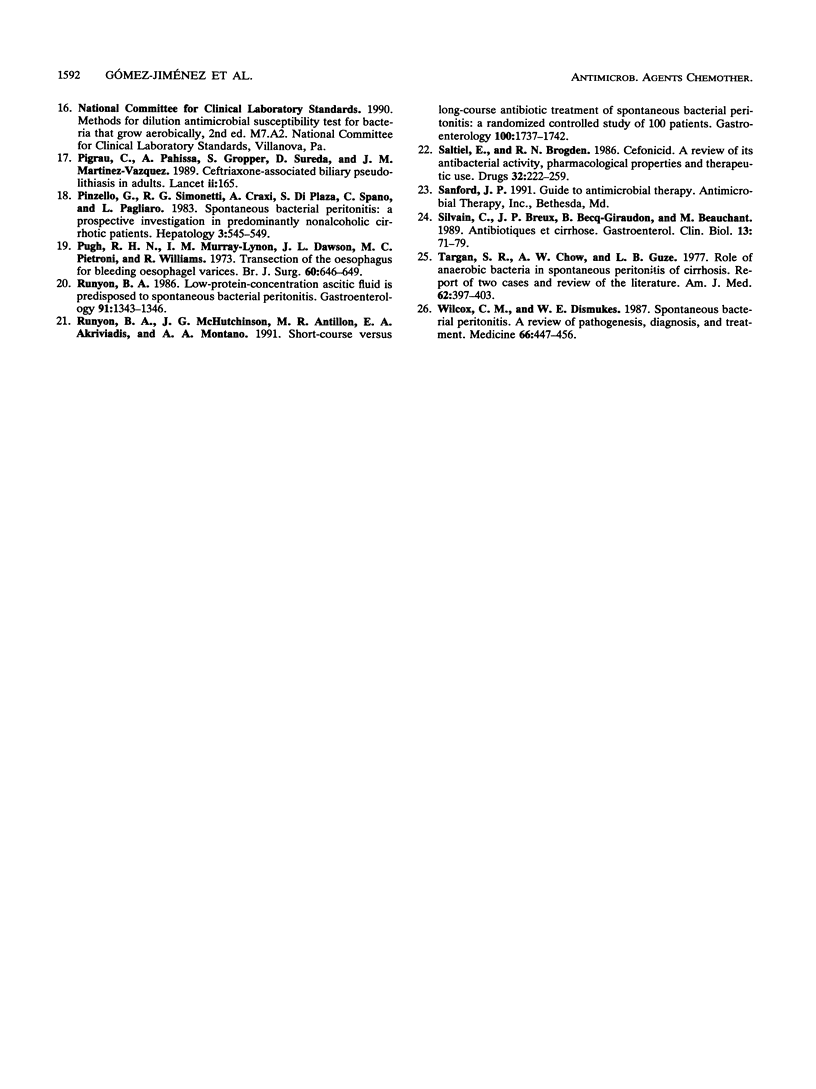Abstract
We compared cefonicid (2 g every 12 h) and ceftriaxone (2 g every 24 h) for their efficacy and safety in treating spontaneous bacterial peritonitis in cirrhotic patients in an open randomized clinical trial (30 patients in each group). Clinical, laboratory, and bacteriologic characteristics were similar in both groups. Ceftriaxone-susceptible strains were isolated on 44 occasions (94%), and cefonicid-susceptible strains were isolated on 43 occasions (91.5%). The antibiotic concentration in ascitic fluid/MIC ratio for ceftriaxone was > 100 throughout the dose interval (24 h), while it was lower for cefonicid (between 1 and 18). A total of 100% of patients treated with ceftriaxone, and 94% of those treated with cefonicid were cured of their infections (P was not significant). Hospitalization mortality was 37% in the cefonicid group and 30% in the ceftriaxone group (P was not significant). The time that elapsed between the initiation of treatment and the patient's death was shorter in the cefonicid group patients (5.3 +/- 3.90 days) than in the ceftriaxone group patients (11.8 +/- 9.15 days) (P < 0.05). None of the patients presented with superinfections, and only two patients treated with cefonicid and three patients treated with ceftriaxone developed colonizations with Enterococcus faecalis or Candida albicans. Ceftriaxone and cefonicid are safe and useful agents for treating cirrhotic spontaneous bacterial peritonitis, although the pharmacokinetic characteristics of ceftriaxone seem to be more advantageous than those of cefonicid.
Full text
PDF





Selected References
These references are in PubMed. This may not be the complete list of references from this article.
- Almdal T. P., Skinhøj P. Spontaneous bacterial peritonitis in cirrhosis. Incidence, diagnosis, and prognosis. Scand J Gastroenterol. 1987 Apr;22(3):295–300. doi: 10.3109/00365528709078594. [DOI] [PubMed] [Google Scholar]
- Ariza J., Gudiol F., Dolz C., Xiol J., Liñares J., Bosch J., Pallares R. Evaluation of aztreonam in the treatment of spontaneous bacterial peritonitis in patients with cirrhosis. Hepatology. 1986 Sep-Oct;6(5):906–910. doi: 10.1002/hep.1840060516. [DOI] [PubMed] [Google Scholar]
- Ariza J., Xiol X., Esteve M., Fernández Bañeres F., Liñares J., Alonso T., Gudiol F. Aztreonam vs. cefotaxime in the treatment of gram-negative spontaneous peritonitis in cirrhotic patients. Hepatology. 1991 Jul;14(1):91–98. doi: 10.1002/hep.1840140115. [DOI] [PubMed] [Google Scholar]
- Bauer A. W., Kirby W. M., Sherris J. C., Turck M. Antibiotic susceptibility testing by a standardized single disk method. Am J Clin Pathol. 1966 Apr;45(4):493–496. [PubMed] [Google Scholar]
- Berger S. A., Dan M., Serour F., Gorea A., Levenberg A., Krispin M. Penetration of third-generation cephalosporins into human peritoneal tissue. Chemotherapy. 1989;35(5):326–329. doi: 10.1159/000238689. [DOI] [PubMed] [Google Scholar]
- Bodey G. P., Ketchel S. J., Rodriguez V. A randomized study of carbenicillin plus cefamandole or tobramycin in the treatment of febrile episodes in cancer patients. Am J Med. 1979 Oct;67(4):608–616. doi: 10.1016/0002-9343(79)90242-0. [DOI] [PubMed] [Google Scholar]
- Cabrera J., Arroyo V., Ballesta A. M., Rimola A., Gual J., Elena M., Rodes J. Aminoglycoside nephrotoxicity in cirrhosis. Value of urinary beta 2-microglobulin to discriminate functional renal failure from acute tubular damage. Gastroenterology. 1982 Jan;82(1):97–105. [PubMed] [Google Scholar]
- Donowitz G. R. Third generation cephalosporins. Infect Dis Clin North Am. 1989 Sep;3(3):595–612. [PubMed] [Google Scholar]
- Felisart J., Rimola A., Arroyo V., Perez-Ayuso R. M., Quintero E., Gines P., Rodes J. Cefotaxime is more effective than is ampicillin-tobramycin in cirrhotics with severe infections. Hepatology. 1985 May-Jun;5(3):457–462. doi: 10.1002/hep.1840050319. [DOI] [PubMed] [Google Scholar]
- Grange J. D., Amiot X., Grange V., Gutmann L., Biour M., Bodin F., Poupon R. Amoxicillin-clavulanic acid therapy of spontaneous bacterial peritonitis: a prospective study of twenty-seven cases in cirrhotic patients. Hepatology. 1990 Mar;11(3):360–364. doi: 10.1002/hep.1840110305. [DOI] [PubMed] [Google Scholar]
- Gómez-Jiménez J., Ribera E., Martínez-Vázquez J. M., Gasser I., Segura R. M. Peritonitis bacteriana del cirrótico. Estudio prospectivo de 80 episodios. Med Clin (Barc) 1992 Oct 24;99(13):493–497. [PubMed] [Google Scholar]
- Hary L., Andrejak M., Leleu S., Orfila J., Capron J. P. The pharmacokinetics of ceftriaxone and cefotaxime in cirrhotic patients with ascites. Eur J Clin Pharmacol. 1989;36(6):613–616. doi: 10.1007/BF00637745. [DOI] [PubMed] [Google Scholar]
- Hell K. Worldwide clinical experience with ceftriaxone. Chemotherapy. 1989;35(3):228–235. doi: 10.1159/000238674. [DOI] [PubMed] [Google Scholar]
- Hoefs J. C., Canawati H. N., Sapico F. L., Hopkins R. R., Weiner J., Montgomerie J. Z. Spontaneous bacterial peritonitis. Hepatology. 1982 Jul-Aug;2(4):399–407. doi: 10.1002/hep.1840020402. [DOI] [PubMed] [Google Scholar]
- Hoefs J. C. Spontaneous bacterial peritonitis: prevention and therapy. Hepatology. 1990 Oct;12(4 Pt 1):776–781. doi: 10.1002/hep.1840120424. [DOI] [PubMed] [Google Scholar]
- Pigrau C., Pahissa A., Gropper S., Sureda D., Martinez Vazquez J. M. Ceftriaxone-associated biliary pseudolithiasis in adults. Lancet. 1989 Jul 15;2(8655):165–165. doi: 10.1016/s0140-6736(89)90228-6. [DOI] [PubMed] [Google Scholar]
- Pinzello G., Simonetti R. G., Craxì A., Di Piazza S., Spanò C., Pagliaro L. Spontaneous bacterial peritonitis: a prospective investigation in predominantly nonalcoholic cirrhotic patients. Hepatology. 1983 Jul-Aug;3(4):545–549. doi: 10.1002/hep.1840030411. [DOI] [PubMed] [Google Scholar]
- Pugh R. N., Murray-Lyon I. M., Dawson J. L., Pietroni M. C., Williams R. Transection of the oesophagus for bleeding oesophageal varices. Br J Surg. 1973 Aug;60(8):646–649. doi: 10.1002/bjs.1800600817. [DOI] [PubMed] [Google Scholar]
- Runyon B. A. Low-protein-concentration ascitic fluid is predisposed to spontaneous bacterial peritonitis. Gastroenterology. 1986 Dec;91(6):1343–1346. doi: 10.1016/0016-5085(86)90185-x. [DOI] [PubMed] [Google Scholar]
- Runyon B. A., McHutchison J. G., Antillon M. R., Akriviadis E. A., Montano A. A. Short-course versus long-course antibiotic treatment of spontaneous bacterial peritonitis. A randomized controlled study of 100 patients. Gastroenterology. 1991 Jun;100(6):1737–1742. doi: 10.1016/0016-5085(91)90677-d. [DOI] [PubMed] [Google Scholar]
- Saltiel E., Brogden R. N. Cefonicid. A review of its antibacterial activity, pharmacological properties and therapeutic use. Drugs. 1986 Sep;32(3):222–259. doi: 10.2165/00003495-198632030-00002. [DOI] [PubMed] [Google Scholar]
- Silvain C., Breux J. P., Becq-Giraudon B., Beauchant M. Antibiotiques et cirrhose. Gastroenterol Clin Biol. 1989 Jan;13(1):71–79. [PubMed] [Google Scholar]
- Targan S. R., Chow A. W., Guze L. B. Role of anaerobic bacteria in spontaneous peritonitis of cirrhosis: report of two cases and review of the literature. Am J Med. 1977 Mar;62(3):397–403. doi: 10.1016/0002-9343(77)90837-3. [DOI] [PubMed] [Google Scholar]
- Wilcox C. M., Dismukes W. E. Spontaneous bacterial peritonitis. A review of pathogenesis, diagnosis, and treatment. Medicine (Baltimore) 1987 Nov;66(6):447–456. [PubMed] [Google Scholar]


